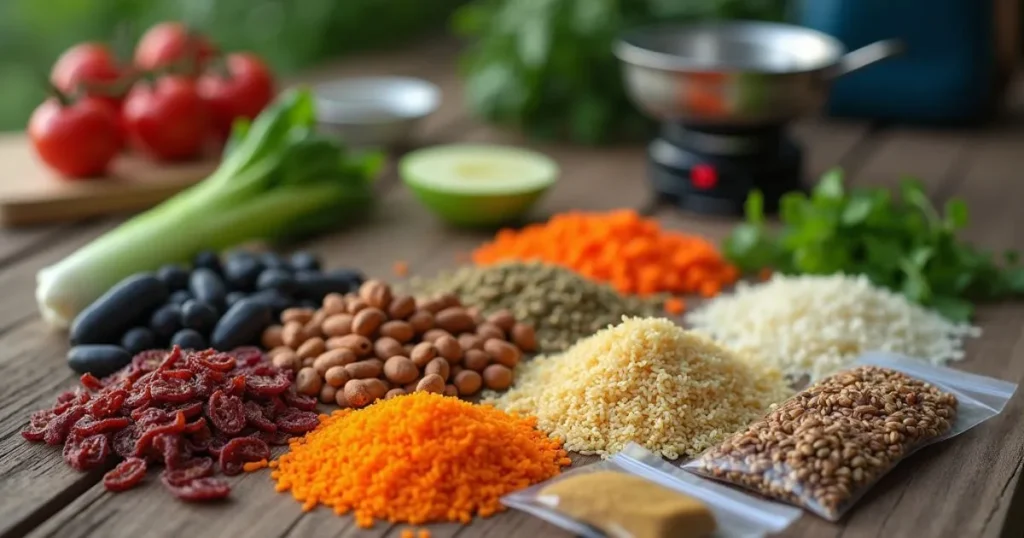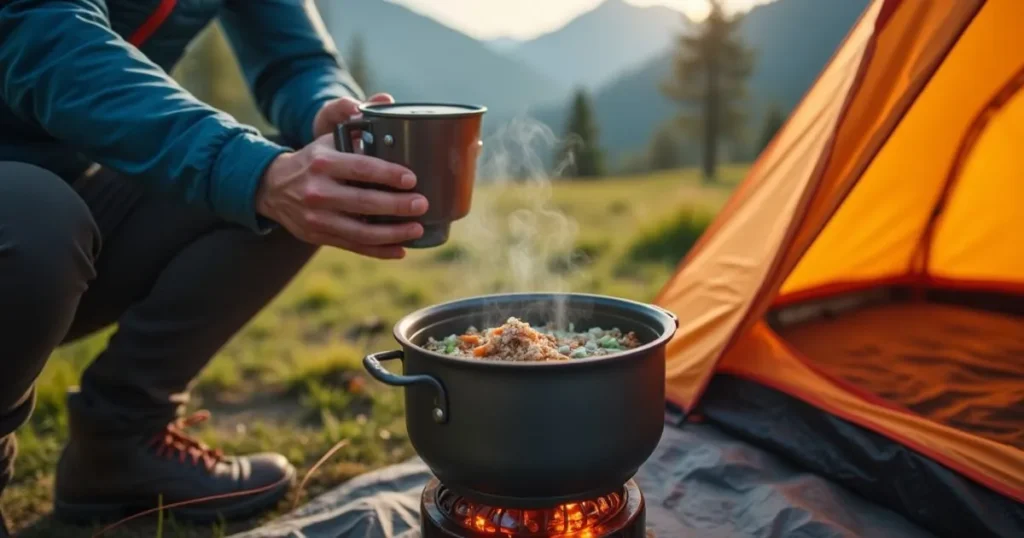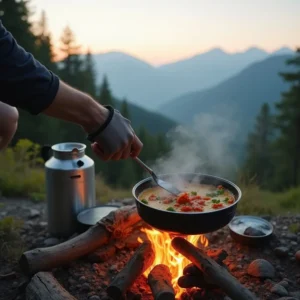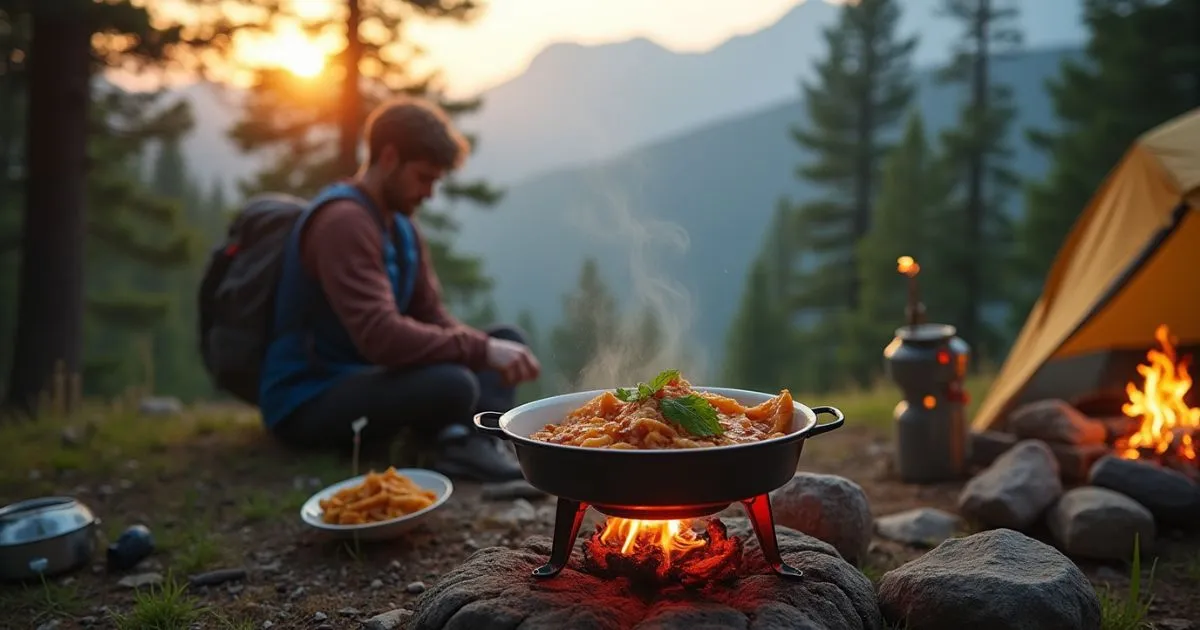Are you ready to elevate your next outdoor adventure with meals that are both easy to prepare and incredibly satisfying? Whether you’re trekking through rugged trails or setting up camp under a canopy of stars, having the right backpacking recipes can make all the difference. Lightweight, trail-friendly, and packed with energy, these recipes are designed to fuel your epic journeys without weighing you down.
Imagine savoring a warm, hearty meal after a long day of hiking—sounds perfect, right? With just a few shelf-stable ingredients and minimal prep, you can create dishes that are as delicious as they are practical. Let’s dive into the essentials of crafting meals that will keep you energized and excited for the adventure ahead!
Table of Contents
Key Benefits
Backpacking recipes are your ultimate ally for making outdoor adventures more enjoyable and stress-free. Here’s why these recipes should top your packing list:
- Lightweight and Portable: Crafted with shelf-stable ingredients, these meals are easy to carry without adding unnecessary weight to your gear.
- Quick and Easy Preparation: Designed for simplicity, most recipes require minimal cooking time and equipment, perfect for busy trail days.
- Nutrient-Packed Energy Boost: Balanced with essential nutrients, these meals help you stay fueled and energized for long hikes.
- Customizable for All Tastes: Whether you’re craving savory, sweet, or something in between, backpacking recipes offer endless flavor possibilities.
- Trail-Tested Durability: Made to last, these recipes hold up in various conditions, from hot days to chilly nights.
No matter your destination, these recipes ensure you stay well-fed and ready for the next adventure. After all, great meals make the best memories, even on the trail!
Ingredients

When it comes to backpacking recipes, choosing the right ingredients can make all the difference. Here’s a handy list to get you started, ensuring your meals are lightweight, nutritious, and easy to prepare on the trail:
Pantry Staples
- Dehydrated Vegetables: Lightweight and packed with nutrients, these add flavor and color to your meals.
- Instant Rice or Quinoa: Quick-cooking grains provide a hearty base for many recipes.
- Powdered Sauces or Broth Mixes: Perfect for adding depth and richness to your dishes.
Protein Options
- Shelf-Stable Tuna or Chicken Packets: Easy to carry and packed with protein.
- Plant-Based Protein Powders: Ideal for vegetarian or vegan options.
- Nuts and Seeds: High-energy snacks that double as meal toppings.
Flavor Boosters
- Spices and Seasoning Packets: Small but mighty, these elevate your meals with bold flavors.
- Parmesan Cheese or Nutritional Yeast: Lightweight options to enhance savory dishes.
- Honey or Maple Syrup: Great for sweet recipes or adding a touch of sweetness to savory meals.
Energy Snacks
- Trail Mix: A classic combo of nuts, dried fruits, and chocolate for quick energy boosts.
- Energy Bars: Compact, calorie-dense snacks perfect for on-the-go munching.
By packing these ingredients, you’ll be ready to whip up meals that are as delicious as they are practical. Remember to portion them in advance to save space and ensure everything stays fresh during your trip!
How to Make Backpacking Recipes

Crafting delicious backpacking meals is easier than you might think. Follow these step-by-step instructions to prepare meals that are quick, satisfying, and perfect for life on the trail:
Step 1: Pre-Trip Preparation
- Plan Your Meals: Decide on recipes that match the length of your trip and your personal taste preferences.
- Pre-Portion Ingredients: Measure out grains, spices, and other dry ingredients into resealable bags or containers to save time and space.
- Rehydrate Ahead of Time (Optional): If using ingredients like beans or lentils, partially rehydrate them at home to reduce cooking time.
- Pack Smart: Use lightweight, compact containers to organize ingredients efficiently.
Step 2: Cooking on the Trail
- Set Up Your Cooking Gear: Most recipes require just a camping stove, a lightweight pot, and a spork. Ensure your gear is clean and ready to use.
- Boil Water: Many backpacking recipes rely on boiling water. Start by heating up the necessary amount for your dish.
- Combine Ingredients: Add your grains, proteins, and seasonings into the pot. Stir well to ensure everything cooks evenly.
- Simmer and Stir: Reduce the heat (or move the pot to the edge of the flame) and let the ingredients simmer. Stir occasionally to prevent sticking.
- Taste and Adjust: Before serving, give your meal a taste. Adjust seasoning with a pinch of salt, a dash of spice, or a drizzle of oil as needed.
Step 3: Clean Up
- Scrape and Pack Out: Scrape leftovers into a waste bag to avoid leaving food behind.
- Rinse and Wipe: Use minimal water to rinse your gear, and wipe it clean with a lightweight cloth.
With these simple steps, you’ll master the art of backpacking cooking. The result? Delicious meals that keep you energized and ready to explore the great outdoors!
Pro Tips and Variations
Backpacking recipes can be as versatile as the trails you explore. Use these tips and creative variations to elevate your meals and tailor them to your preferences:
Pro Tips
- Pre-Cook When Possible: For shorter trips, pre-cook grains like rice or quinoa and dehydrate them. This saves time and fuel on the trail.
- Invest in Quality Gear: A lightweight, multi-purpose camping stove and a collapsible pot can streamline your cooking process.
- Opt for Multi-Use Ingredients: Choose ingredients that work across multiple meals, like powdered broth for soups and sauces or tortillas for wraps and pizzas.
- Don’t Forget Hydration: Use your meal prep time to boil extra water for hot drinks or to refill your hydration pack.
- Label Everything: Mark resealable bags with the meal name and cooking instructions for hassle-free preparation.
Variations
- Vegan Power Bowl: Combine instant quinoa, dehydrated chickpeas, sun-dried tomatoes, and a dash of curry powder for a plant-based feast.
- Southwest Wrap: Pack tortillas, black beans, powdered cheese, and taco seasoning. Rehydrate the filling and wrap it up for a handheld treat.
- Sweet Tooth Treat: Mix instant oats with powdered milk, cinnamon, and dried fruits. Add hot water for a warm, comforting dessert.
- Spicy Ramen Upgrade: Elevate instant noodles with a splash of soy sauce, chili flakes, and pre-cooked jerky or tofu cubes.
Bonus Tip
Pack a small bottle of olive oil or ghee to add a rich flavor boost and extra calories to your meals. It’s lightweight, versatile, and makes a big difference in taste!
Experiment with these ideas, and you’ll turn every backpacking meal into a highlight of your adventure. Happy cooking!
Serving Suggestions
Backpacking meals aren’t just about convenience—they can also be satisfying and enjoyable. Here are some serving suggestions to make your trail dining experience feel a little more special:
Portion Wisely
- Individual Portions: Pre-portion meals to ensure everyone gets enough fuel without overpacking. Use collapsible bowls for easy serving.
- Family-Style Sharing: If traveling with a group, cook a larger batch and serve it straight from the pot to minimize cleanup.
Add a Finishing Touch
- Fresh Herbs: Pack lightweight options like dried parsley or a small bundle of fresh thyme for garnish.
- Toppings: Sprinkle meals with shredded cheese, crushed nuts, or a drizzle of olive oil to enhance flavors and textures.
Pair Your Meals
- Hot Drinks: Pair hearty dishes with a mug of instant coffee, hot cocoa, or herbal tea for a comforting boost.
- Side Snacks: Serve alongside trail mix, crackers, or dehydrated fruits for extra energy and variety.
Stay Organized
- Use compact utensils like sporks and foldable plates to keep your serving setup efficient and manageable.
- Keep wet wipes or a small cloth handy for quick cleanup after meals.
By adding thoughtful touches to your backpacking recipes, you can transform a simple trail meal into a memorable dining experience—because even in the wild, a little effort goes a long way!
Conclusion
Backpacking recipes are a game-changer for outdoor enthusiasts who want to enjoy delicious, nutritious meals on the go. Whether you’re a seasoned hiker or a first-time adventurer, knowing how to prepare easy, trail-friendly meals can elevate your experience and keep you energized throughout your journey.
From lightweight ingredients to quick preparation and creative variations, the key to successful backpacking meals lies in thoughtful planning and simple yet flavorful recipes. With the tips and tricks shared here, you’ll be well on your way to crafting satisfying meals that will fuel your epic adventures.
So, next time you lace up your boots and head for the great outdoors, remember that great food is just as important as great views. Happy cooking—and even happier hiking!

Backpacking Recipes
Ingredients
- Pantry Staples:
- Dehydrated vegetables
- Instant rice or quinoa
- Powdered sauces or broth mixes
- Protein Options:
- Tuna or chicken packets
- Plant-based protein powders
- Nuts and seeds
- Flavor Boosters:
- Spices and seasoning packets
- Parmesan cheese or nutritional yeast
- Honey or maple syrup
- Energy Snacks:
- Trail mix
- Energy bars
Instructions
- Pre-Trip Prep: Portion ingredients, pre-rehydrate if needed, and pack in lightweight containers.
- Cooking on Trail: Boil water, add ingredients, simmer, and stir. Adjust seasoning to taste.
- Clean Up: Scrape leftovers, rinse with minimal water, and wipe gear clean.
Notes
- Calories: 350 kcal
- Fat: 15g
- Protein: 10g
- Carbohydrates: 40g
- Fiber: 6g
- Sugar: 5g
- Sodium: 400mg
FAQs
Backpacking meals are a new territory for many, and it’s natural to have questions. Here are some frequently asked questions to help you make the most of your outdoor cooking experience:
1. Can I make backpacking recipes without a stove?
Yes! Many backpacking recipes can be made without a stove by using a simple no-cook method. Consider dehydrated meals, ready-to-eat snacks, or cold-soaked oats that only require water. You can also use a portable kettle or campfire to heat water for instant meals.
2. How do I store leftovers on the trail?
Leftovers can be tricky to store, especially on longer trips. To minimize waste, try to cook only the amount you’ll need, or pack a small container for leftovers. If you have any extra food, be sure to seal it tightly and store it away from wildlife.
3. What’s the best way to keep my meals fresh?
To keep your meals fresh, opt for lightweight, resealable bags and airtight containers. Choose shelf-stable ingredients that don’t require refrigeration. For items that need to stay cool, use a small cooler or insulated pouch.
4. Can I make meals in advance for my trip?
Absolutely! Prepping meals at home and dehydrating them is a great way to save time on the trail. You can rehydrate meals with hot water or by soaking them overnight, and they’ll be ready to enjoy when you need them.
5. How can I make my backpacking meals more flavorful?
Seasonings and sauces are key to elevating the flavor of your meals. Don’t be afraid to pack spice blends, bouillon cubes, or small jars of olive oil and honey. Adding a pinch of chili flakes, garlic powder, or fresh herbs can make a world of difference.
These are just a few tips to help ensure your backpacking meals are as delicious and easy as possible. Have more questions? Drop them in the comments, and happy trails!
Recipe Recap: Backpacking Recipes for Easy and Epic Adventures
Recipe Details:
- Prep Time: 10 minutes
- Cook Time: 20 minutes
- Total Time: 30 minutes
- Servings: 4
- Calories: 350 kcal per serving
Nutrition Information (per serving):
- Calories: 350 kcal
- Fat: 15g
- Protein: 10g
- Carbohydrates: 40g
- Fiber: 6g
- Sugar: 5g
- Sodium: 400mg
Categorize the Recipe:
- Course: Main Course
- Cuisine: Outdoor / Camping
- Diet: Vegan (with optional protein variations)
- Method: Stovetop, No-Cook Options
- Keyword: Backpacking Meals, Easy Trail Recipes, Outdoor Cooking
- Skill Level: Beginner
This recipe is a perfect fit for anyone looking for convenient, satisfying meals that don’t sacrifice flavor on the trail. Whether you’re planning a short day hike or a longer backpacking adventure, these easy-to-make meals will keep you energized and ready for the next leg of your journey.
